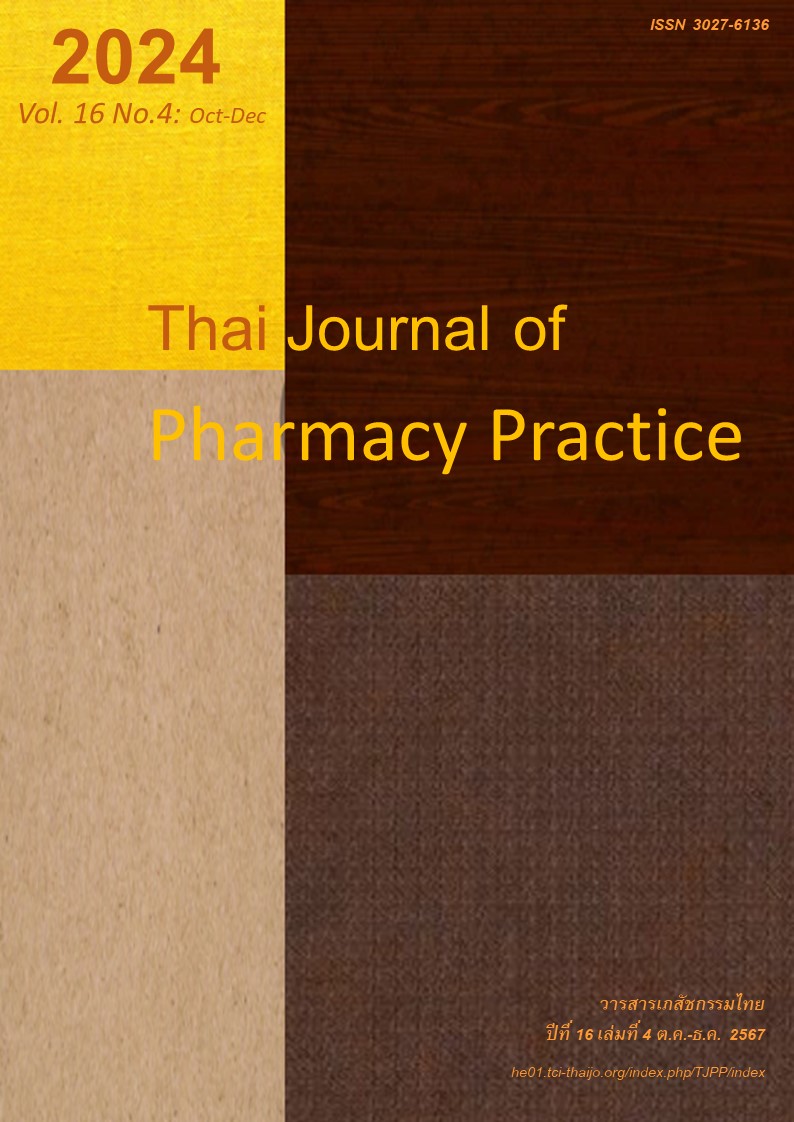ผลลัพธ์ของการใช้โปรแกรมประยุกต์ไลน์เพื่อจัดการด้านยา ในผู้ป่วยโรคความดันโลหิตสูงที่ควบคุมอาการไม่ได้
Main Article Content
บทคัดย่อ
วัตถุประสงค์: เพื่อพัฒนาและประเมินผลการใช้โปรแกรมประยุกต์ไลน์เพื่อจัดการด้านยา (โปรแกรมประยุกต์ไลน์ฯ ) ในผู้ป่วยโรคความดันโลหิตสูงที่ควบคุมอาการไม่ได้ วิธีการ: การศึกษาแบ่งเป็น 2 ระยะ ได้แก่ ระยะที่ 1 เป็นขั้นพัฒนาโปรแกรมประยุกต์ไลน์ฯ จากกรอบแนวคิดการให้ข้อมูลด้านโรค การสร้างแรงจูงใจ และการพัฒนาทักษะ (Information, motivation, behavioral skills model) ร่วมกับการสนทนากลุ่มระหว่างบุคลากรทางการแพทย์และการสัมภาษณ์ผู้ป่วย ระยะที่ 2 เป็นการประเมินผลลัพธ์ของโปรแกรมประยุกต์ไลน์ฯ ผู้วิจัยสุ่มแบ่งผู้ป่วยเป็นกลุ่มทดลองและกลุ่มควบคุม กลุ่มละ 66 คน กลุ่มทดลองได้รับบริการมาตรฐานโรงพยาบาลร่วมกับโปรแกรมประยุกต์ไลน์ฯ กลุ่มควบคุมได้รับบริการมาตรฐานโรงพยาบาลเพียงอย่างเดียว การศึกษาติดตามระดับความดันโลหิตและความพึงพอใจหลังจากเข้าร่วมการศึกษา 3 เดือน ผลการศึกษา: ในระยะที่ 1 ผู้วิจัยนำเสนอโปรแกรมประยุกต์ไลน์ฯ ที่พัฒนาขึ้นต่อผู้เชี่ยวชาญด้านเนื้อหาและสื่อพบว่า คุณภาพเนื้อหามีค่าเฉลี่ยเท่ากับ 4.54±0.50 จากคะแนนเต็ม 5 และระบบสนับสนุนระบบสารสนเทศโปรแกรมประยุกต์ไลน์ฯ มีค่าเฉลี่ยคุณภาพเท่ากับ 4.48±0.68 จากคะแนนเต็ม 5 ระยะที่ 2 หลังจากเข้าการศึกษาเป็นเวลา 3 เดือนพบว่า ค่ามัธยฐาน (พิสัยควอไทล์) ของความดันซิสโตลิกในกลุ่มทดลองน้อยกว่ากลุ่มควบคุมอย่างมีนัยสำคัญทางสถิติ (136 (5.25) และ 144 (7) mmHg ตามลำดับ, P <.001) และความดันไดแอสโตลิก ในกลุ่มทดลองน้อยกว่ากลุ่มควบคุมอย่างมีนัยสำคัญทางสถิติเช่นกัน (77 (6.50) และ 80 (7.25) mmHg ตามลำดับ, P =0.002) กลุ่มทดลองมีความพึงพอใจต่อโปรแกรมประยุกต์ไลน์ฯ ในภาพรวมมีค่าเฉลี่ยเท่ากับ 4.40±0.55 จากคะแนนเต็ม 5 สรุป: โปรแกรมประยุกต์ไลน์ฯ ทำให้ผู้ป่วยที่ควบคุมระดับความดันโลหิตไม่ได้ มีระดับความดันโลหิตลดลงอย่างมีนัยสำคัญทางสถิติ
Article Details

อนุญาตภายใต้เงื่อนไข Creative Commons Attribution-NonCommercial-NoDerivatives 4.0 International License.
ผลการวิจัยและความคิดเห็นที่ปรากฏในบทความถือเป็นความคิดเห็นและอยู่ในความรับผิดชอบของผู้นิพนธ์ มิใช่ความเห็นหรือความรับผิดชอบของกองบรรณาธิการ หรือคณะเภสัชศาสตร์ มหาวิทยาลัยสงขลานครินทร์ ทั้งนี้ไม่รวมความผิดพลาดอันเกิดจากการพิมพ์ บทความที่ได้รับการเผยแพร่โดยวารสารเภสัชกรรมไทยถือเป็นสิทธิ์ของวารสารฯ
เอกสารอ้างอิง
Chockalingam A, Campbell NR, Fodor JG. Worldwide epidemic of hypertension. Can J Cardiol 2006; 22: 553-5.
Divison of Non Commuicable Disease. Mortality rate of hypertension [online]. 2020 [cited Sept 5, 2021]. Available from: thaincd.com/2016/mission/document s-detail.php?id=13893&tid=32&gid=1-020.
Divison of Non Commuicable Disease. Key perform- ance indicator for monitoring the quality of non- communicable disease services [online]. 2022 [cited Feb 2, 2022]. Available from: ddc.moph.go.th/up loads/publish/1186620211006043036.pdf.
Puengdokmai P, Charoenkitkarn V, Pinyopasakul W, Sriprasong S, Dumavibhat C. Factors influencing medication adherence in hypertensive patients without complications. Princess of Naradhiwas University Journal 2016; 8: 16-26.
Lertwiriyanan R. The relevant factors for controlling blood sugar and blood pressure of diabetes mellitus and hypertension pateints in Mae phang sub-district, Sansai district, Chiang mai province. Lanna Public Health Journal 2013; 9: 216-38.
Wilson J, Heinsch M, Betts D, Booth D, Kay-Lambkin F. Barriers and facilitators to the use of ehealth by older adults: a scoping review. BMC Public Health 2021; 21: 1556. doi.org/10.1186/s12889-021-11623-w
Electronic Transaction Development Agency, Ministry of Digital Economy and Society. Thailand internet user behavior [online]. 2020 [cited Sept 10, 2021]. Available from: www.etda.or.th/getattachment/c583 5c06-e238-4cda-9816-814df31caca5/IUB_2020_ Web.pdf.aspx.
Nitipaiboon J. The improvement of the capability in social media and applications usage for elderly. Journal of Communication Arts Review 2021; 25: 77-89.
Fisher JD, Fisher WA. Changing AIDs-risk behavior. Psychol Bull1992; 111: 455-74.
Polhan B, Wattanakitkrileart D, Pongthavornkamol K. The effects of education and inhaler skills program through Line application on symptom control among asthmatic patient. Journal of the Royal Thai Army Nurses 2018; 20: 93-103.
Mahaviriyotai K, Wattanakitkrileart D, Poungkaew A. The effect of information provision, motivation and self-monitoring skill program through line application on self-care behaviors in patients with heart failure. Nursing Science Journal of Thailand 2021; 39: 47-63.
Chirawatkul A. Statistics for health science research. Bangkok: Wittayaphat Publishing; 2015.
Gong K, Yan Y-L, Li Y, Du J, Wang J, Han Y, et al. Mobile health applications for the management of primary hypertension: A multicenter, randomized, controlled trial. Medicine (Baltimore) 2020; 99: e19715. doi: 10.1097/MD.0000000000019715.
Schoenthaler A, Leon M, Butler M, Steinhaeuser K, Steinhaeuser K. Development and evaluation of a tailored mobile health intervention to improve medication adherence in black patients with uncontrolled hypertension and type 2 diabetes: Pilot randomized feasibility trial. JMIR Mhealth Uhealth 2020; 8: e17135. doi: 10.2196/17135.
Li X, Li T, Chen J, Xie Y, An X, Lv Y, et al. A wechat-based self-management intervention for community middle-aged and elderly adults with hypertension in Guangzhou, China: A cluster-randomized controlled trial. Int J Environ Res Public Health 2019; 16: 4058. doi: 10.3390/ijerph16214058.
Tahkola A, Korhonen P, Kautiainen H, Niiranen T, Mantyselka P. Personalized text message and checklist support for initiation of antihypertensive medication: the cluster randomized, controlled check and support trial. Scand J Prim Health Care 2020; 38: 201-9. doi: 10.1080/02813432.2020.1753380.
Detboon S, Kitsripisarn S, Muengtaweepongsa S. The effects of a motivational program using a mobile application for adherence behaviors in the prevention of recurrent stroke and blood pressure among stroke patients with hypertension. Nursing Journal CMU 2023; 50: 97-111.
Lertsinudom S, Mungmanitmongkol S, Prasertsuk S, Taratai K, Phenphinan S, Tuntapakul S, et al. System design of Tele pharmacy service in new normal of hospital and drugstore in Regional Health 7 [online]. 2022 [cited Jun 11, 2023]. Available from: kb.hsri.or.th/dspace/handle/11228/5496?locale-attribute=th.
Sakulsupsiri A, Chattranukulchai P, Siwamogsa tham S, Boonchayaanant P, Naeowong W, Ariyachai panich A, et al. Home blood pressure control and drug prescription patterns among Thai hypertensives : A 1-year analysis of telehealth assisted instrument in home blood pressure monitoring nationwide pilot project. Int J Hypertens. 2021; 2021: 8844727. doi: 10.1155/2021/8844727.
Thongkao S, Kimsungnoen N, Namjuntra R. Effects of educative-supportive program on self-care behaviors and blood pressure levels among young adult patients with uncontrolled hypertension. Thai Journal of Cardio-Thoracic Nursing 2021; 32: 73-88.
Kanchanapibulwong A, Khamwangsanga P, Kaew- tha S. NCDs report diabetes, hypertension and related risk factors [online]. 2019 [cited Mar 10,2022]. Available from: www.thaincd.com/2016/ media-detail.php?id=13865&tid=&gid=1-015-005.
Promrat S, Kapol P, Kapol N. Effects of a program to promote medication adherence using telephar- macy in pateints with hypertension. Thai Bulletin of Pharmaceutical Sciences 2022; 17: 31-41.
Charoenwongsa K, Wirojratana V, Wattanakitkrileart D. The effect of a medication adherence promotion program through the Line application on older persons with essential hypertension. Nursing Journal CMU 2022; 49: 313-25.
Nakhornriab S, Wattanakitkrileart D, Charoenkitkarn V, Chotikanuchit S, Vanijja V. The effectiveness of mobile application on medication adherence in patients with stroke. J Nurs Sci. 2017; 35: 58-69.
Mira JJ, Navarro I, Botella F, Borras F, Nuno-Solinis R, Orozco D, et al. A Spanish pillbox app for elderly patients taking multiple medications: randomized controlled trial. J Med Internet Res. 2014; 16: e99. doi: 10.2196/jmir.3269.
The Blood Pressure Lowering Treatment Trialists’ Collaboration. Pharmacological blood pressure lowering for primary and secondary prevention of cardiovascular disease across different levels of blood pressure: an individual participant-level data meta-analysis. Lancet 2021; 397: 1625-36. doi: 10.1016/S0140-6736(21)00590-0.


